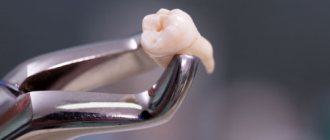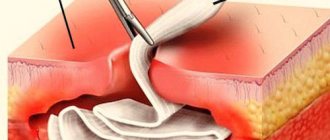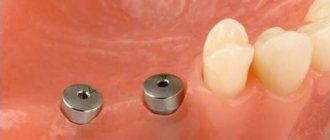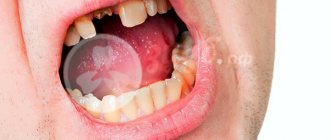What are crown + root modules?
Previously, in the case of complete destruction of the front tooth, but with the presence of a healthy root, the crown was attached to a pin - now pins are a thing of the past and are replaced by a single CEREC module “crown + root”
When restoring three or four consecutive front teeth, we can recommend the installation of a bridge-like orthopedic structure - a fused connection of several crowns. But many patients choose separate crowns for each tooth, which are not only more practical, but also look more aesthetically pleasing.
What prostheses can be placed in the smile zone - the most complete list of solutions and their features
Article navigation
- Indications for prosthetics
- Important Features
- Prosthetic options
- Removable prosthetics
- Fixed dentures
- Implantation of incisors and canines
- Which dentures are better?
- Which material to choose
- In what situations is enamel grinding not necessary?
- Periodontitis and periodontal disease
- Contraindications
- Dentists' recommendations
- Price
Question for a specialist
People practically do not use incisors for chewing food, which is why when restoring them, high demands are placed mainly only on aesthetics and restoration of the correct bite. It is very important that your smile looks natural and natural. However, the material must still be strong enough to withstand the average load of biting food. Because of all these features, prosthetics of the front teeth contains many nuances, which will be discussed further.
Indications for prosthetics in the smile area
When thinking about prosthetics for the upper or lower front teeth, you need to know in what cases it is necessary. It is clear that the complete absence of an incisor or canine tooth along with the root is a direct indication for prosthetics. But there are other cases when it is a prosthesis in the classical sense that is needed, and not a filling. Let's look at the main indications for prosthetics in the smile area:
- chipped crown: the defect is more than half of its original size,
- cracks in the enamel or its abrasion,
- malocclusion: only in case of minor pathologies it is corrected with dentures, otherwise braces/aligners (orthodontic aligners) are needed,
- frequent caries under fillings,
- enamel defects: darkening, smoker’s plaque, “tetracycline” staining, fluorosis, thin enamel layer,
- complete absence of a tooth along with the root.
That is, prosthetics are necessary to recreate the aesthetics and functionality of a smile, as well as to create a more attractive appearance. The latter is especially true for public people and women.
Installation of dentures for anterior teeth without turning
This is the restoration of damaged teeth, when the neighboring teeth intended for support are not ground down or depulped. In this case, it is worth performing implantation. This is one of the most gentle and atraumatic methods of installing upper and lower teeth. The essence of the method is that in the place of the lost tooth, an implant is installed in the jaw bone tissue, which performs the function of a root. Subsequently, a crown is put on it.
There are also methods that do not require grinding of a layer of healthy teeth, but they are rather temporary.
Important features of restoration of incisors and canines
Features of prosthetics of the anterior teeth of the lower and upper jaw are as follows:
- it is important to recreate the aesthetics of the smile and face: choose the right shape and color of dentures that are identical to the enamel of neighboring units of the dentition,
- it is important to pay attention to the position of the gums: the contour of the mucous membrane should be natural and natural,
- it is important to ensure good fixation of the prosthesis: so that a person can not only smile, but also bite and chew food normally (although biting off very hard foods will no longer be possible in any case),
- It is important that the restoration does not cause discomfort and does not provoke pathologies: allergies or inflammation.
South Korean implant Osstem - from 35,000 rubles.
Hurry up to sign up for a free consultation and lock in promotional prices.
Call now or request a call
Opening hours: 24 hours a day - seven days a week
Implantation of lower teeth
Loss of bone tissue in the frontal region is observed quite often. Especially if the tooth has been missing for more than 2 years or was lost due to injury. Since the front teeth do not bear large chewing loads, problems with fixation in the bone are solved due to the design features of the implant, allowing in most cases to do without osteoplastic intervention. In the presence of severe atrophy, implantation of the lower anterior teeth, as well as the upper ones, is carried out simultaneously with osteoplasty.
Removable prosthetics and its features
- When to use: if one or more front teeth are missing along with the roots, that is, they are completely removed.
The peculiarity of removable dentures is that they are fixed to the supporting teeth with hooks (clasps). These clasps are noticeable when you smile (if the hooks are made of metal) or often become loose and break (if the clasps are made of plastic). The attachments can damage the enamel of the supports or the surrounding gums, causing inflammation. By the way, this can also include a rapid decline in aesthetics, because plastic teeth quickly darken from plaque, and it will not be possible to whiten them to an ideal state.
Most often, a removable butterfly prosthesis is placed on the front teeth (if the chewing ones are preserved) - and only as a temporary solution. In other cases, in order to also partially restore the chewing teeth, you will have to make a massive prosthesis with a voluminous plastic palate or gum - this way it will hold better, but with less comfort.
In orthopedic dentistry, there are the following types of removable dentures:
- acrylic: made of long-known and inexpensive acrylic plastic,
- Acry-free (“Acry-free”): a modern variation of the previous type. Made from plastic that contains virtually no acrylic monomer (somewhat a toxic substance found in conventional acrylics),
- polyurethane: Russian alternative to nylon structures. The material is soft and flexible,
- clasp: unlike all the others, clasps have a metal arch, which adds rigidity and more correctly distributes the chewing load. The upper palate is not made solid, but in the form of a small bridge, which increases wearing comfort. Clasp ones will be placed only if at least part of the lateral teeth is missing, otherwise they simply cannot be fixed,
- Quattro Ti (“Quadrotti”): similar to clasp ones in structure and scope, but “Quadrotti” do not have a metal arc. They are made only from Dental D material (a combination of nylon and plastic), patented by Quattro Ti.
To read about each individual type of prosthesis, click on the name to go to the corresponding page with a description.
What are Lumineers and when are they used?
Lumineers are another type of orthopedic plates designed primarily to correct the color and shape of the tooth surface. The installation of lumineers, unlike veneers, is carried out in one visit and does not involve grinding of the dentition. That is why there is no need to wear temporary structures before installing them. Lumineers also have an undeniable advantage over composite restorations: thin ceramic plates do not darken over time.
However, there are also disadvantages. Since lumineers are installed on an unground surface, it is sometimes very difficult to achieve a tight fit to the teeth. In addition, the tooth on which the lumineer is attached differs from the natural dentition in size and shape, so it is not recommended to correct local defects with its help.
Fixed dentures to restore the smile area
- When to use: if teeth have lost their aesthetics, are partially destroyed, there are chips - these are indications for installing veneers or crowns. If the teeth are missing along with the roots, then bridges are placed.
Fixed ones correspond to almost all features of prosthetics, since they are highly aesthetic, are well fixed, and the absence of plastic gums and palate makes wearing them quite comfortable. But all this provided that an experienced orthopedist was involved in the prosthetics, high-quality materials and technological equipment were used.
%akc72%
The advantage of non-removable ones is that they last much longer than removable ones. Fixed ones do not move, they do not need to be taken out of the mouth to clean (and the person will not forget to put them back), they do not need to be glued to the cream, and there is no need to get used to a foreign object in the mouth. The disadvantages include the cost, which is significantly higher than that of removable ones.
Aesthetic prosthetics – veneers, lumineers, ultraneers
Veneers, lumineers and ultraneers are durable and aesthetic microprostheses for the smile area; they are installed only on the front part of the dentition and mask minor defects, creating a “Hollywood smile”. They can cover cracks in the enamel, small chips, interdental spaces (diastemas and trema), and slightly level the inclination of the teeth.
Veneers (in fact, lumineers and ultraneers are also veneers) are presented in the form of thin ceramic overlays. Their thickness varies between 0.3-0.6 mm. And if ultraneers are just thin veneers (0.3 mm), then lumineers are already a patented brand with its own manufacturing technology (the thickness of lumineers is about 0.2 mm). You can evaluate the aesthetics of lumineers restoration using photos before and after prosthetics of the front teeth.
Among the positive aspects of veneers are the highest aesthetics and durability (10-20 years of trouble-free wear). The disadvantages include very careful operation of the restoration, high cost, and the need to install 6-8 veneers or lumineers per row at once. But in the case of classic veneers, it is possible to replace one or two front teeth.
Traditional prosthetics with crowns
If the top is destroyed by more than half, but the roots are intact, it is recommended to use dental crowns.
A crown is a cap-shaped prosthesis that restores a single defect and is placed on some kind of support. It perfectly follows the shape of the natural tooth apex and is fixed very firmly with special cement. But it is rarely possible to remove a crown without damaging it, for example, to treat root canals or periodontitis. In this case, you have to make a new one. And after several removals/fixations, a situation often arises that the root has to be removed (if it is severely damaged due to caries or frequent treatment). Then it is no longer possible to install a crown; you have to look for other prosthetic options.
To fix the crowns, a certain support is required:
- the preserved part of the natural tooth apex: it is previously ground down to give the shape of a stump or a truncated cone,
- post: a metal screw that is secured into the tooth root. The advantages of the method are low price, the disadvantages are uneven load on the root, insufficient fastening reliability,
- stump tab: a more successful (but also expensive) analogue to a pin. The inlay can be made of durable metal-free materials, the shape exactly follows the cavity inside the root and rises above the gum so that the crown can be fixed to it. Metal-free materials transmit light in a similar way to natural tooth enamel. This option looks more aesthetically pleasing and will last many times longer than pins.
Bridges
They are used when 1-4 teeth are missing in a row. A necessary condition is the presence of supports (or their healthy roots) along the edges of the defect.
Bridges (or bridges) are several crowns connected in a row. Bridges differ from single crowns in that they do not have holes at the bottom and rest on the gums, and the outer ones are created for fixation on supports. Also, “wings” – located along the edges of the bridge – can be attached to these supports.
Adhesive bridges1 have just such “wings”. These bridges are temporary, but are fixed quite reliably (they can come off due to chewing gum or very hard food). The installation can be performed on children and adults - on a temporary basis while awaiting implantation, for example.
The advantages of bridges include high aesthetics, long-term fixation and comfortable operation. But they have a very big drawback - the need to grind down the supports and remove their “dental nerves”. These factors, plus additional chewing load, lead to rapid failure of the supports. You have to re-treat them, and eventually remove them - and each time you need to redo the bridges or make new ones. As a result, when the defect becomes very extensive, you will have to completely abandon bridges in favor of other types of prosthetics.
Another significant disadvantage is that when wearing bridges (as well as removable structures), the bone will constantly atrophy under the plastic base or “empty” crowns. Along with the bone, the gums also recede, making the smile unattractive and allowing food to accumulate in the space between the denture and the gums. After every few months of wearing it, you have to go to an orthopedist and adjust the displaced prosthesis.
Prosthetic replacement of anterior tooth after extraction
After tooth extraction, it is better to do its prosthetics using the express implantation technique, in the absence of contraindications. To do this, immediately after tooth extraction, an implant and a special abutment are installed in its alveolar socket to form the correct gum shape. A crown is temporarily placed on it. After the implant has healed for approximately several months, a permanent crown is installed.
The advantages of express implantation include:
- This procedure does not require any additional incisions, which is less traumatic to the gums;
- The implant is installed in an open manner, which also does not require additional surgical intervention;
- This method is perfect for patients who do not want to wait until the hole heals and a bridge or crown can be installed.
- Short healing period;
- There are few side complications that are unpleasant for the patient.
Implantation of incisors and canines – installation of 1 crown and bridge on implants
- When to use: in the absence of any number of teeth on any of the jaws. These may be single or isolated defects; an entire segment or all teeth may be missing at once. You can even place an implant in the hole of a recently removed tooth root.
An implant is an artificial metal root that is fixed in the bone tissue if there is no tooth root in it. When restoring anterior teeth, it is recommended to install a white aesthetic abutment made of zirconium dioxide. It also corrects the position of the gums, which allows you to achieve ideal aesthetics.
Today, the most ideal method of prosthetics in dentistry is dental implantation. It is suitable for any area of the dentition, with any number of defects - from single and scattered to complete edentia. The most significant advantages of implantation look like this:
- no need to grind down adjacent teeth,
- the highest possible aesthetics – crowns on implants are completely indistinguishable from natural teeth,
- very strong fixation of the implant in the bone and the crown on the implant itself,
- ability to withstand good loads: but the frontal zone should not be overloaded,
- materials for implantation are biocompatible with the body,
- implant-supported dentures have the highest wearing comfort,
- the service life of the implant is eternal, and the prosthesis on it will last at least 15-25 years,
- implants help rebuild the bone around them, maintaining gum level.
Crowns or bridges are placed on top of the implants, as well as bridges with small inclusions of artificial gum (to mask the uneven contour of the natural gum).
Implantation of artificial teeth
A modern, long-lasting option for the restoration of front teeth is implantation. This operation involves inserting a special pin into the jaw bone, in the place where a tooth is missing, which will act as a tooth root and will counteract atrophic changes in bone tissue. This pin is made of titanium and does not cause any inconvenience or complications in the future. Then a crown made of ceramic is installed on this titanium rod. Implantation makes it possible not to touch the healthy teeth in the neighborhood. For this procedure, high-quality durable implants from the Nobel Biocare brand are used, which are guaranteed for life. The implanted tooth will not differ in any way from the rest, since the crown is made after measurement and exactly matches the shape and natural shade of the teeth. Another technique for using dentures on the front teeth is installing a bridge.
The name “bridge” was borrowed from technicians, since its installation uses the principle of constructing bridges. A bridge is a type of permanent dental prosthesis; they are used to replace defects of several teeth (up to four) in a row. To do this, special crowns are installed on the adjacent good teeth, between which the prosthesis will be placed. The negative quality of this technique is the need to grind down the surface and remove the pulp of healthy teeth on which crowns will be placed. The bridge also needs to be replaced at least once every few years. But with these disadvantages, this method allows you to avoid surgical intervention.
To summarize: which prostheses are better?
Which prosthesis is better to choose for prosthetics of front teeth? Let's summarize all the information already available and determine the optimal solution.
| Problem | The best decision |
| If 1 tooth is missing with a root | The crown on the implant will last from 15 years, and the service life of the implant is decades |
| If several teeth are missing | A segment or several crowns, again installed on implants |
| If the top is chipped | If the chip is small - less than 30% of your own enamel, then a veneer is placed. If most of it is missing, a crown on a pin or stump tab |
| If the top is destroyed | If the roots are healthy and intact, then a crown is placed on the stump tab. If the roots are destroyed, they are removed and an implant is placed. |
Summary: which crowns are best for the front teeth?
And now the most difficult thing remains - it is easy to answer the question about the best choice of crowns for the front teeth. By the way, if you don’t go into the issue of price, the choice will be quite simple (the cost of all the above types of crowns – see the links above). The most budget option is metal ceramics, the price for 1 Unit of which starts from approximately 10,000 to 12,000 rubles.
At the same time, highly aesthetic metal-ceramics will cost you from 20,000 to 25,000 rubles (for 1 Unit), which, in principle, already corresponds to the lower price limit for ceramic crowns from Emax Press. In general, the economical option for crowns for the front teeth is only metal-ceramics, or the only option left is temporary crowns made of Multi-PMMA plastic, which are made by milling (they last up to 2 years).
Next, we look at the optimal prosthetic options:
- If you need 1 or several single crowns, in this case it is optimal to choose pressed ceramics Emax. Slightly less optimal are zirconium crowns, the frame of which is milled from pre-colored “Multi-layer” zirconium dioxide, on top of which layers of porcelain will be applied.
- Prosthetics for all front teeth at once – i.e. when we are talking about prosthetics for 8-10 front teeth (at least one jaw). In this case, it is optimal to choose monolithic zirconium crowns “Multi-layer”. The second choice is Emax ceramics, and both varieties are suitable here.
- If you need a bridge, the E.max PRESS pressed ceramic bridge is an excellent choice, because... this will give very good aesthetics. But bridges from this material can be made with a length of no more than 3 Units (i.e., only with a single missing tooth). In this case, it is important to take into account the presence and condition of the chewing teeth, because If you don't have a lot of chewing teeth, an Emax bridge may not be a good choice (it may not withstand excessive chewing pressure and break).
The second choice is a zirconia bridge. But you probably already realized that if you need to make a bridge of 4 or more units, then in any case it is made only from zirconium dioxide (Emax ceramics will not work here), or metal ceramics. At the same time, if we are talking about extended bridges for all front teeth, then it would be optimal to use monolithic zirconium dioxide “Multi-layer”.If we are talking about a bridge prosthesis of short length, then from an aesthetic point of view it is better to make the bridge non-monolithic, i.e. in this case, only the frame is milled from “Multi-layer” zirconium dioxide, which is then lined with layers of porcelain mass. But in this case, there is a small risk of porcelain chipping (in 10% of cases within 5 years of operation), but the chips are still repairable.
Additional recommendations –
From an aesthetics point of view, the situation when you are replacing symmetrical teeth with crowns (for example, 4 central incisors at once or a group of 8-10 front teeth at once) is simpler, and in this case you can choose more economical prosthetic options.
The most difficult options are when you need to take only 1 front tooth or 2-3 teeth, asymmetrically located in relation to the center of the dentition (24stoma.ru). The latter is due to the fact that the human eye primarily pays attention to the differences between symmetrical objects. In addition, if you have a gummy type of smile (the gums are exposed when you smile), this will also require choosing more expensive crown options than in patients whose only the incisal edges of the front teeth are slightly visible when smiling.
Choosing crowns on implants –
When prosthetics of anterior teeth supported by implants, the choice of crowns is reduced to metal-ceramics and zirconium dioxide. However, the first option will have all the usual disadvantages of traditional metal ceramics, i.e. It will be difficult to achieve good aesthetics in patients with high transparency of tooth enamel, and secondly, blueness of the gums will be guaranteed.
Therefore, the optimal prosthetic option in this case would be to choose a zirconium crown, which is installed on a zirconium abutment. You can read more about the pitfalls of prosthetics on implants in the article at the link below.
→ Choosing a crown for a dental implant, price
What material to choose for dentures in the smile area
- plastic and metal-plastic: the most affordable option, but has poor aesthetics and a short service life, therefore it is used only as a temporary solution,
- metal ceramics: a durable and inexpensive option, but not aesthetically pleasing enough for the smile area. In addition, if the metal comes into contact with the gum, it will turn blue over time - this will be noticeable,
- solid ceramics: looks as natural as possible and is quite durable, especially provided that in the frontal area the load on the teeth is minimal,
- Zirconium dioxide or aluminum oxide: the most preferred option, natural, strong and durable. But also the most expensive.
When is metal ceramics used?
Metal-ceramic crowns are one of the most popular options in orthopedic dentistry. It is used quite often because it has an affordable price, high strength and aesthetics. However, they are best used to restore the masticatory sections, but not the anterior ones.
The disadvantages of metal ceramics are as follows:
- may cause allergies: in this case, the cobalt-chromium alloy can be replaced with gold, but the cost of treatment will increase significantly,
- when metal and gums come into contact, “cyanosis” of the mucous membrane may occur,
- your own tooth enamel must be sharpened,
- Mandatory nerve removal is required, even if the root canals are healthy.
When to use ceramics
A more preferable option for the frontal zone. Moreover, modern ceramics have become stronger and more durable. Such dentures are distinguished by natural translucency, the ability to select the shade of ceramics in full accordance with the color of natural enamel. They do not cause blue gums and require minimal grinding of the own enamel, while the dental nerve (if indicated) can be preserved. The only drawback is that they are higher in price than metal-ceramic ones. In addition, it is not advisable to fix them on implants or pins - a metal base can lead to splitting of the structure. Solid ceramics are attached only to your own tooth or core inlay.
When is zirconium dioxide used?
Zirconium dioxide or aluminum oxide are durable materials that are processed using modern computerized equipment. CAD/CAM technology is used to create a customized prosthesis, as well as scanning the entire oral cavity and modeling structures in a computer program. This allows you to achieve incredible precision at all stages of prosthetics. Among the main advantages are the longest service life (from 15-20 years), incredible aesthetics of both the restoration itself and the gum area, the absence of allergic reactions and minimal grinding of the enamel.
Not only crowns and bridges, but also veneers can be made from ceramics and zirconium dioxide.
Don't know what type of prosthetics to choose?
We will help in the selection, advise where to read more information and compare types of prosthetics.
Consultation with an orthopedic doctor in Moscow clinics is free! Call now or request a call
Working hours: from 9:00 to 21:00 - seven days a week
Dental crowns: what are they?
Dental crowns are divided into types based on the material used. The most modern option would be crowns made of metal-free ceramics - zirconium dioxide or Emax glass ceramics (they will allow you to achieve the highest level of aesthetics). As for metal-ceramic crowns, their aesthetics may be no worse than ceramic ones, but in this case the price will be appropriate. But budget options for metal ceramics have very modest aesthetics.
But there are even more budget options: metal-plastic, as well as ordinary cast metal crowns. Speaking of how much a crown costs per tooth, the price will depend on the type of artificial crown, as well as the pricing policy of the dental clinic. The cost of a crown per tooth for 2022 in economy class and mid-price clinics will be (per 1 unit) –
- metal ceramics – from 10,000 to 20,000 rubles,
- ceramic crown “Emax” – on average 25,000 rubles,
- zirconium dioxide crown – from 30,000 to 40,000 rubles,
- all-metal - about 5,000 rubles.
Important: as you will see below, such a range in prices is dictated, as a rule, not by the greed of dental clinics, but by the fact that materials of different quality can be used in the manufacture of crowns, as well as less or more labor-intensive methods for their manufacture. For example, if you were offered metal ceramics for 8,000 or 10,000 rubles, then be sure that in this case the cheapest materials of Belarusian or Russian production will be used (24stoma.ru).
The use of cheap ceramic mass (porcelain) does not allow achieving acceptable aesthetics in the area of the front teeth, plus this is fraught with an increased risk of chipping the ceramics. Acceptable aesthetics of metal ceramics can be expected starting from 12,000 rubles, and good aesthetics – from 15,000 rubles for 1 Unit (i.e. 1 crown). In general, there are many subtle points on which the quality of your crowns will depend, and we will try to talk about all of this in detail below.
In what situations is enamel grinding not necessary?
How is prosthetics performed in the frontal area? First, the oral cavity is prepared - caries is treated, tartar and plaque are removed, and if necessary, diseased roots are removed. Then, if you need to place a crown, bridge or veneers, you first need to grind down the supports. After this, impressions are taken (you can also perform a 3D scan of the oral cavity), which are sent to the laboratory. But turning can be avoided if the following restoration options are chosen - lumineers, clasp on hooks, immediate or removable dentures.
Prosthetic options for anterior teeth
- Temporary and permanent;
- Removable and non-removable.
Temporary prostheses are needed for emergency filling of the defect. This option is performed for a broken tooth, extraction, and when removing or replacing other dentures. To do this, temporary plastic prostheses or removable dentures are used to close the existing defect. The wearing period of such implants is 30-60 days. This time will be enough to make a permanent prosthesis and sanitize the oral cavity.
Permanent prosthetics are performed after the root implant has healed, with healthy neighboring teeth, and in the absence of inflammatory changes in the oral cavity.
Removable prosthetics can be used in people who, due to contraindications, cannot currently perform such a procedure and it is postponed for some time. Or when it is not possible to install a prosthetic bridge due to the lack of more than four teeth in a row or the supporting teeth are damaged. Such patients are recommended to wear removable dentures.
Fixed prosthetics are carried out according to indications and include the following techniques:
- Implantation;
- Bridge prosthetics;
- Installation of crowns;
- Installation of veneers or lumineers.
There are several options for prosthetics of the upper and lower front teeth
Periodontitis and periodontal disease - is it possible to get dentures with such a diagnosis?
If you have periodontitis and periodontal disease, there are not many options for restoring your smile. For example, it could be a splinting “clasp” that will fix loose teeth, but will not cure periodontitis or periodontal disease. Therefore, these pathologies will have to be treated regularly, although they never go away 100%, especially in the later stages.
The ideal option again is implantation, because... implants are not natural roots on which plaque would accumulate, leading to the progression of periodontitis. Implants even promote the regeneration of your own bone and, accordingly, increase the level of gums. But here it is important to understand that it is often impossible to do without removing the remaining diseased teeth or their roots, because they are the source of infection.
Contraindications for prosthetics
All existing contraindications relate for the most part to fixed prosthetics. Moreover, there are many relative contraindications – those that can be “bypassed” over time. For example, relative prohibitions on the installation of fixed bridges or crowns, as well as implants, are imposed on the following groups of patients:
- children under 18 years of age, pregnant women: this is due to the characteristics of bone tissue and the ban on certain anesthetics,
- for diseases of the oral cavity: caries, pulpitis, stomatitis - first you need to be cured,
- for periodontitis and periodontal disease: with classic removable and fixed prosthetics, as well as with two-stage implantation. BUT! When implanted using one-stage protocols - for example, with basal implantation or all-on-6, these pathologies are not considered a contraindication.
There is, perhaps, only one absolute contraindication for removable orthopedic structures, which, by the way, also applies to non-removable ones - these are very serious mental disorders. Also, absolute contraindications, but for implantation, include the following:
- decompensated diabetes mellitus,
- serious pathologies of the heart and blood vessels, endocrine system,
- malignant diseases in the acute stage,
- tuberculosis, HIV,
- inability to carry out high-quality oral hygiene.
Recommendations from dentists when choosing a prosthesis
When restoring small defects, chips and darkening, it is better to choose thin ceramic veneers or lumineers - they will make your smile beautiful for 15 years or more.
Removable orthopedic solutions in the smile area often lose their fixation, move, provoke allergies and cause difficulty chewing medium-hard food. Therefore, it is recommended to install them only as a temporary option: while the patient waits for the installation of a permanent fixed prosthesis or implant. Here, a defect in a row or a ground stump is masked with a plaster or bridge so that the smile retains its attractive appearance. Biting food with these restorations is not recommended. On an ongoing basis only if there are contraindications to fixed solutions or implantation, as well as financial limitations.
Fixed options for restoring minor dental defects, such as crowns and bridges, are quite popular due to their availability. If the natural crown is destroyed by more than half, then a worthy option is a ceramic or zirconium dioxide crown coated with ceramics. But in the case of a bridge, the patient is not immune from bone atrophy and gum loss under the prosthesis, as well as from overloading the supports.
Therefore, the optimal method for restoring the frontal zone will be implantation, because implants prevent the bone from further atrophying and maintain the aesthetics of your smile for several decades.
By the way, positive reviews from 90% of patients who underwent implantation speak of the highest comfort of life even 10-15 years after prosthetics. While 60% of people who have had classic removable prosthetics or bridges subsequently regret their decision.
Combined crowns/bridges –
An example of one of the combinations of materials in the manufacture of crowns is metal-plastic (Fig. 14-15). They, like cast crowns, are made using a solid casting method from a cobalt-chrome alloy, but the front surface is subsequently additionally lined with white plastic. The price for metal-plastic crowns will be from 7,000 rubles per unit, and their advantages include acceptable aesthetics.
Disadvantages of metal-plastic crowns –
- Plastic in the oral cavity quickly loses its aesthetic properties, and over time, the white color of the plastic changes to gray. In addition, plastic tends to absorb liquid and swell slightly. This causes the plastic to begin to smell like unbrushed teeth over time.
- Metal-plastic crowns are also not very reliable: if the teeth are clenched tightly or while chewing, the plastic lining may simply fall out.
- Plastic is not very good for health (especially for allergy sufferers), because... there is always some amount of chemically active monomer remaining in it. The latter can be released for a very long time.
Combined bridges –
The metal frame of metal-ceramics and cast metal crowns are made according to the same principle - using the one-piece casting method. Therefore, different types of crowns can be combined in one bridge. For example, you need to make a bridge of 3 units (supported by teeth 5-7). In this case, the first 1-2 crowns falling into the smile line are made of metal-ceramic, and the distant crowns are made of solid casting (Fig. 16).
Dentists and dental technicians are not very fond of such designs, because... this reduces their cost. And if they tell you that this cannot be done, then this will only speak of the doctor’s personal reluctance. Moreover, such designs have other advantages (besides the price). For example, teeth for cast crowns require much less grinding than for metal-ceramic crowns, and therefore this design can last longer.
The cost of restoring the smile area
How much does front tooth replacement cost? It all depends on the type of prosthesis, its design, complexity of manufacturing and installation, as well as on the materials and rating of the clinic. For example, restoration of a single defect with a composite veneer costs from 7,000 rubles, with a ceramic veneer – from 15 thousand, and one lumineer costs from 50 thousand.
Prices for metal-ceramic crowns start from 6,500 rubles, for ceramic ones – from 18 thousand, and zirconium dioxide – from 25 thousand. The cost of the bridge is calculated according to the number of crowns. A butterfly prosthesis costs from 12 thousand, a plate prosthesis can be ordered for 15-20 thousand, and clasp prostheses, Acri-free and Quadrotti cost from 35-40 thousand rubles. Installation of 1 implant on a turnkey basis, i.e. together with the crown, it will cost at least 35-40 thousand rubles - this is the most budget option, and premium brands cost 2-3 times more.
- Ervandyan A. G. Clinical and laboratory justification for the use of adhesive bridges made of ormokers and fiber materials: Dis. Ph.D. honey. Sci. Moscow, 2005. - 140 p.
Crowns made of metal-free ceramics –
Unlike metal-ceramic crowns, these crowns are made entirely of ceramics and do not have a metal frame inside, which can significantly improve their aesthetics. For the manufacture of ceramic crowns in dental clinics, 2 types of ceramics are most often used - either zirconium dioxide or Emax ceramics. However, these materials are not equal in their aesthetic properties, and in addition, they have different manufacturing options that will differ in aesthetics - even from each other.
For example, there are two fundamentally different types of zirconia crowns. In general, we want to say that the choice is not as obvious (as it may seem), and therefore in different clinical situations we will recommend either zirconium dioxide crowns or Emax crowns.
Zirconium dioxide ceramic crowns –
In the manufacture of zirconium crowns, CAD/CAM technology is used, which involves the production of crowns/bridges from pressed blocks of zirconium dioxide - by milling them on a computer-controlled machine. Zirconium dioxide is a variant of ceramics, which in the sintered state has a strength comparable to metal (more than 900 MPa). The price for 2022 for 1 crown in Moscow will average from 30,000 to 40,000 rubles, although in the regions the price may be slightly lower, starting from 25,000 rubles.
Prosthetics with zirconium dioxide: before and after photos
There are 2 types of zirconium crowns. The first option is made from cheap zirconium dioxide blocks, which have a bright white color + are completely opaque, which absolutely does not correspond to the color and transparency of natural tooth tissues. To achieve more or less decent aesthetics, only the internal frame is milled from zirconium dioxide, onto which, after sintering, layers of ceramic mass (porcelain) are applied. It is precisely due to the layers of porcelain that such crowns can be given a more or less natural look.
But such crowns not only have modest aesthetics, but also have another big disadvantage - it consists in chipping the ceramics. The fact is that only the internal zirconium frame will have a strength of 900 MPa, while the strength of the surface layers of porcelain will be no more than 80-120 MPa. As a result, according to statistics, at least 10% of patients experience ceramic chips after a few 5 years (when using this type of zirconium crowns).
The second type is monolithic zirconium crowns “Multi-layer”. Multi-layer technology means that in this case pre-colored zirconium dioxide blocks will be used (i.e. having a gradient of color and transparency). Real living teeth also have such a gradient, starting from the neck of the tooth and towards the incisal edge/cusps of the chewing teeth. Therefore, crowns made from “Multi-layer” zirconium dioxide will be as similar in color and transparency as possible to real teeth.
Zirconium multi-layer crowns –
In the photo above, you can see the aesthetics of single crowns and bridges made of zirconium dioxide, made using the “Multi-layer” technology (they have just been manufactured and are still being fixed on a plaster model of the patient’s teeth). The bridge prosthesis in the projection of 14-15-16 teeth is made with pink artificial gum, and the remaining units are made in the form of single zirconium crowns. Pay attention to the natural color and transparency, which change in direction - from the necks of the crowns to the cutting edge.
A huge plus of multi-layer zirconium dioxide crowns is that they are monolithic. Those. these crowns will be made entirely of zirconium dioxide only (i.e. they will not have a porcelain surface layer, the presence of which can lead to chipping of the ceramic). Monolithic multi-layer zirconia crowns are the best option for many clinical situations. Let's look at what clinical situations such crowns would be optimal for:
- always when it comes to prosthetics of chewing teeth (crowns or bridges),
- always when it comes to implant-supported prosthetics,
- when replacing anterior teeth - depending on the situation*.
*Features of using zirconium on the front teeth –
Good aesthetics when using zirconium crowns in the area of the front teeth cannot always be achieved. The aesthetics will be wonderful if you are going to prosthetize all the front teeth of one jaw at once, or 4 front incisors at once, or all the incisors along with the canines (see photo of the work above). But if you need to make only 1-2 crowns, then it is not a fact that the dental technician will be able to make them 100% similar to the adjacent natural teeth.
The fact is that when working with zirconium dioxide, the dental technician has a limited range of color solutions, which often does not allow such crowns to be completely invisible against the background of neighboring real teeth. When working with other types of ceramics (for example, Emax ceramics), the dental technician has more color options. And therefore, if you only need to make 1-2-3 crowns, then it is better to abandon zirconium dioxide crowns - in favor of “Emax” crowns made of pressed ceramics.
Important: but there is a small exception, which we will talk about in the section on Emax ceramics. Well, the last important point is that “Multi-layer” zirconium dioxide blocks can be of very different quality. Everything here is the same as with the quality of porcelain mass for the manufacture of metal-ceramics - you need to know the manufacturer. In the article at the link below, you can also familiarize yourself with the best options for “multi-layer” zirconium dioxide blocks, which will make the most aesthetic options for zirconium crowns.
→ Cost and features of zirconium crowns
Ceramic crowns made of glass ceramics E-max –
Glass ceramics E.max is the best type of metal-free ceramics for prosthetics of anterior teeth. With crowns and bridges made from Emax, you can achieve truly ideal aesthetics, and all this is thanks to the characteristics of the material, which is not for nothing called glass-ceramics. The basis of this material is lithium disilicate, the crystals of which, in color and transparency, almost completely match the color and transparency of natural tooth enamel.
It is this circumstance, as well as a wide range of color options, that allows the dental technician to make artificial crowns that will not differ from the patient’s real teeth. The price for 1 crown for 2022 will be on average from 25,000 rubles (in the regions it may be slightly lower). But in some Moscow clinics the price can be higher - up to 40,000 rubles per 1 Unit.
E.max glass-ceramic crowns – before and after photos
However, E.max cannot be done in all clinical situations in the oral cavity. Only single crowns can be made from this material, as well as bridges no more than 3 units long - with fixation primarily on the front teeth (the far support of the bridge should not be more than 5 teeth inclusive). Such limitations are associated with the strength characteristics of the material (400 MPa). But with single E.max crowns you can restore both front and chewing teeth.
Crowns/bridges made of E.max (as well as crowns/bridges made of zirconium dioxide) can be either monolithic or made in the form of a pressed frame, onto which layers of ceramic mass will subsequently be applied. There are 2 main E.max materials - “E.max PRESS” and “E.max CAD”. Crowns from the first material are made by pressing under conditions of high pressure and temperature, and from the second - using CAD/CAM technology (read more about E.max in the link below).
→ Cost and features of E.max crowns









